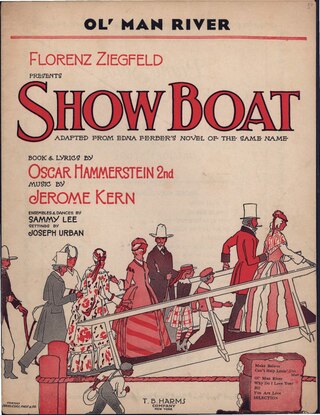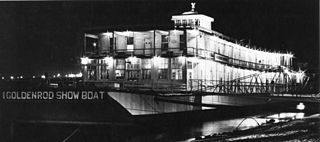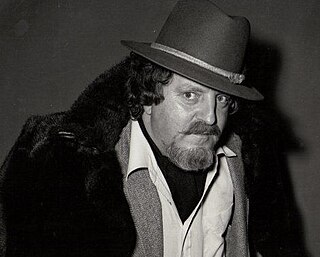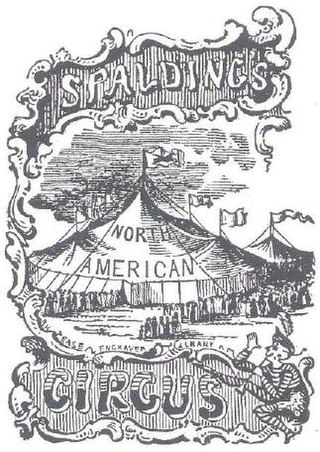
Robert Fulton was an American engineer and inventor who is widely credited with developing the world's first commercially successful steamboat, the North River Steamboat. In 1807, that steamboat traveled on the Hudson River with passengers from New York City to Albany and back again, a round trip of 300 nautical miles, in 62 hours. The success of his steamboat changed river traffic and trade on major American rivers.

Edna Ferber was an American novelist, short story writer and playwright. Her novels include the Pulitzer Prize-winning So Big (1924), Show Boat, Cimarron, Giant and Ice Palace (1958), which also received a film adaptation in 1960. She helped adapt her short story "Old Man Minick", published in 1922, into a play (Minick) and it was thrice adapted to film, in 1925 as the silent film Welcome Home, in 1932 as The Expert, and in 1939 as No Place to Go.

A steamboat is a boat that is propelled primarily by steam power, typically driving propellers or paddlewheels. Steamboats sometimes use the prefix designation SS, S.S. or S/S or PS ; however, these designations are most often used for steamships.

Show Boat is a musical with music by Jerome Kern and book and lyrics by Oscar Hammerstein II. It is based on Edna Ferber's best-selling 1926 novel of the same name. The musical follows the lives of the performers, stagehands and dock workers on the Cotton Blossom, a Mississippi River show boat, over 40 years from 1887 to 1927. Its themes include racial prejudice and tragic, enduring love. The musical contributed such classic songs as "Ol' Man River", "Make Believe", and "Can't Help Lovin' Dat Man".

"Ol' Man River" is a show tune from the 1927 musical Show Boat with music by Jerome Kern and lyrics by Oscar Hammerstein II, who wrote the song in 1925. The song contrasts the struggles and hardships of African Americans with the endless, uncaring flow of the Mississippi River. It is sung from the point of view of a black stevedore on a showboat, and is the most famous song from the show. The song is meant to be performed in a slow tempo; it is sung complete once in the musical's lengthy first scene by the stevedore "Joe" who travels with the boat, and, in the stage version, is heard four more times in brief reprises. Joe serves as a sort of musical one-man Greek chorus, and the song, when reprised, comments on the action, as if saying, "This has happened, but the river keeps rolling on anyway."

Belle of Louisville is a steamboat owned and operated by the city of Louisville, Kentucky, and moored at its downtown wharf next to the Riverfront Plaza/Belvedere during its annual operational period. The steamboat claims itself the "most widely traveled river steamboat in American history." Belle of Louisville's offices are aboard Mayor Andrew Broaddus, and also appears on the list of National Historic Landmarks.

Show Boat is a 1929 American pre-Code sound part-talkie romantic drama film based on the 1926 novel Show Boat by Edna Ferber. The film initially did not use the 1927 stage musical of the same name as a source, but scenes were later added into the film incorporating two of the songs from the musical as well as other songs. Many of these songs from the stage show were featured in a special prologue that was added to the picture before it was released. This film was produced and released by Universal. Like the majority of films during the early sound era, a silent version was made for movie theatres that had not yet converted to sound.
"Can't Help Lovin' Dat Man" with music by Jerome Kern, and lyrics by Oscar Hammerstein II, is one of the most famous songs from their classic 1927 musical play Show Boat, adapted from Edna Ferber's 1926 novel.

The Majestic is a historic riverboat that is moored on the Ohio River at Manchester, Ohio. Built in 1923, she was the last floating theater to be built in the United States, and one of its longest-lived. She was declared a National Historic Landmark on December 20, 1989.
Julie Dozier is a character in Edna Ferber's 1926 novel Show Boat. In the Jerome Kern and Oscar Hammerstein II's classic musical version of it, which opened on Broadway on December 27, 1927, her stage name is Julie La Verne. She is exposed as Julie Dozier in Act I. In Act II, Julie has changed her name, this time to Julie Wendel.
A showboat or show boat, is a boat which serves as a floating theater.

Goldenrod was a floating theater, known as a showboat, which operated on the Mississippi River and its tributaries throughout the 20th Century. She was designated a U.S. National Historic Landmark on 24 December 1967 and a St. Louis, Missouri City Landmark in 1972. She was placed on the 'Threatened Historical Landmarks' list in 2001. On 21 October 2017, the boat burned to her hull and was sold for scrap. In a meeting held 15–16 August 2023, the National Park System Advisory Board (NPSAB) recommended to withdraw the National Historic Landmark designation of Goldenrod due to her loss of historical integrity. Her landmark designation was withdrawn in December 2023.

Minnesota Centennial Showboat was a traditional riverboat theatre docked at Harriet Island Regional Park on the banks of the Mississippi River in downtown Saint Paul, Minnesota, United States. The showboat contained an intimate jewelbox theatre that seated 225. The interior was decorated to keep in time with the Victorian Era style commonly associated with showboats. The Minnesota Centennial Showboat was run through a partnership with the University of Minnesota Theatre Department and the Padelford Boat Company. The showboat was a longtime tradition with the University beginning in 1958. The University Theatre utilized the showboat as a learning opportunity for its students to experience professional theatre. The showboat had its final performance in 2016.

Show Boat is a 1926 novel by American author and dramatist Edna Ferber. It chronicles the lives of three generations of performers on the Cotton Blossom, a floating theater on a steamboat that travels between small towns along the banks of the Mississippi River, from the 1880s to the 1920s. The story moves from the Reconstruction Era riverboat to Gilded Age Chicago to Roaring Twenties New York, and finally returns to the Mississippi River.

M/V Mississippi is a United States Army Corps of Engineers (USACE) towboat operating on the Mississippi River. It is the largest diesel towboat on the river.

The Clinton Area Showboat Theatre is a summer stock professional theatre in Clinton, Iowa. Currently run by Executive Producer James Kyle Davis, the showboat has been drydocked on the Army Corps of Engineers Levee. With a 217-seat theater, the Clinton Showboat has produced musicals and comedies for 39 years.
The James Adams Floating Theatre was a floating theater founded in 1914 by James Adams and his wife Gertrude, that toured Chesapeake Bay staging theater in Maryland, Virginia, and North Carolina. It was visited in 1925 by Edna Ferber, who boarded the vessel in Bath, North Carolina, while writing the 1926 novel which inspired Jerome Kern and Oscar Hammerstein II’s Broadway show Show Boat. After the James and Beulah retired in 1917, the management of the theater was turned over to Charles Hunter and his wife Beulah Adams Hunter.

G. William "Bill" Oakley, Jr. was a theatrical producer-director-actor and seminal figure in the revival of early American theater, melodrama and vaudeville with theaters in Colorado and Missouri.

Callie M. Leach French was an American steamboat captain and pilot. For much of her career as a captain, she worked with her husband, towing showboats along the Ohio, Monogahela and Mississippi Rivers. She played the calliope, cooked, sewed, and wrote jokes for the showboat theater. She never had an accident in her career and was the first woman to hold a masters and pilot's license for a steamboat.

"Dr." Gilbert Reynolds Spalding, sometimes spelled Spaulding, was an American showman, circus owner and innovator, being the first to own his own showboat, constructed the first showboat to contain an entire circus and in 1856 the first to send an entire circus on tour in its own railroad cars.



















